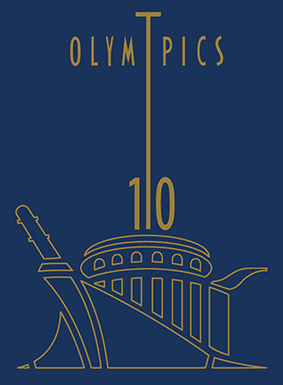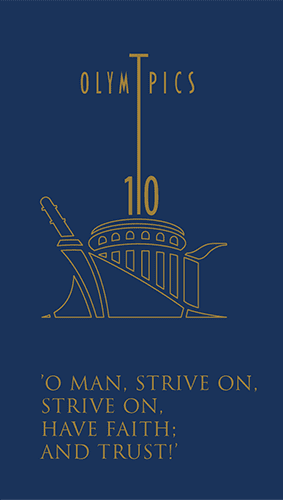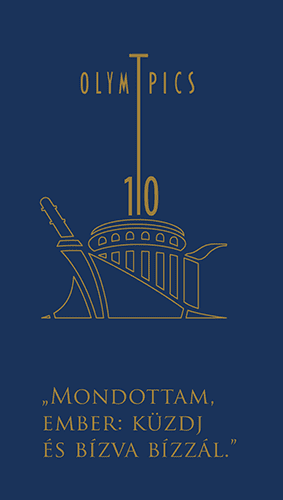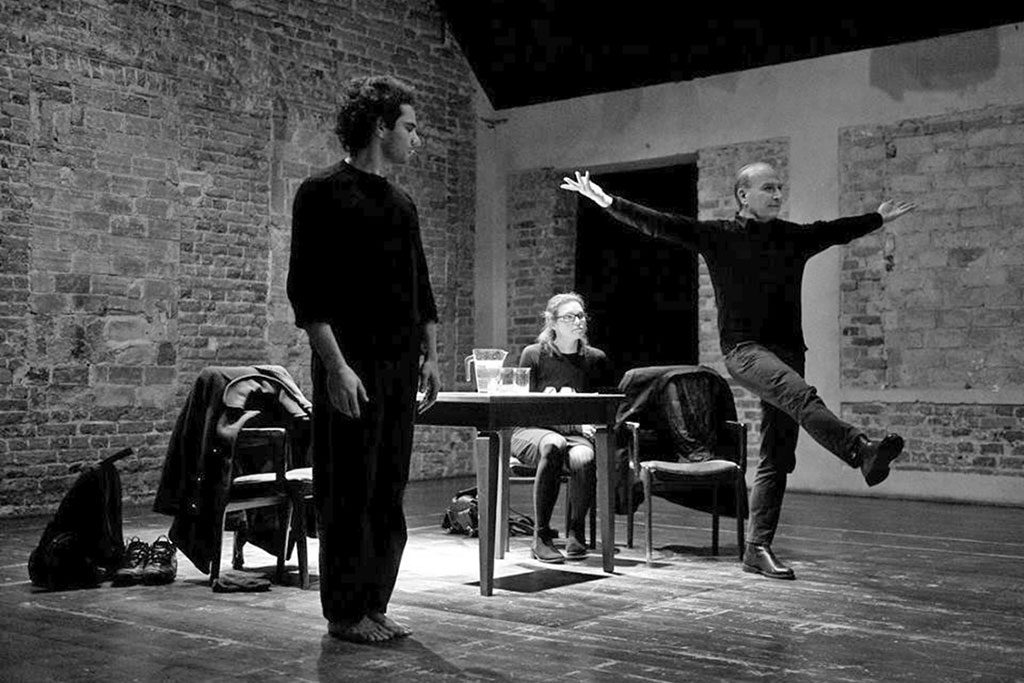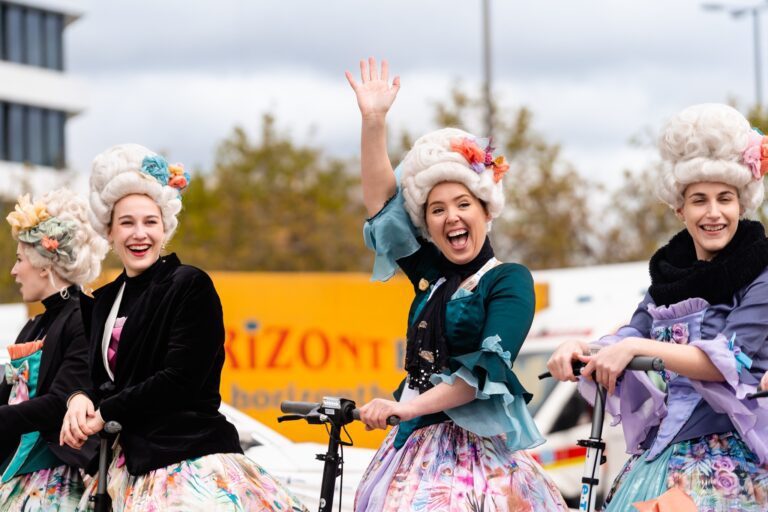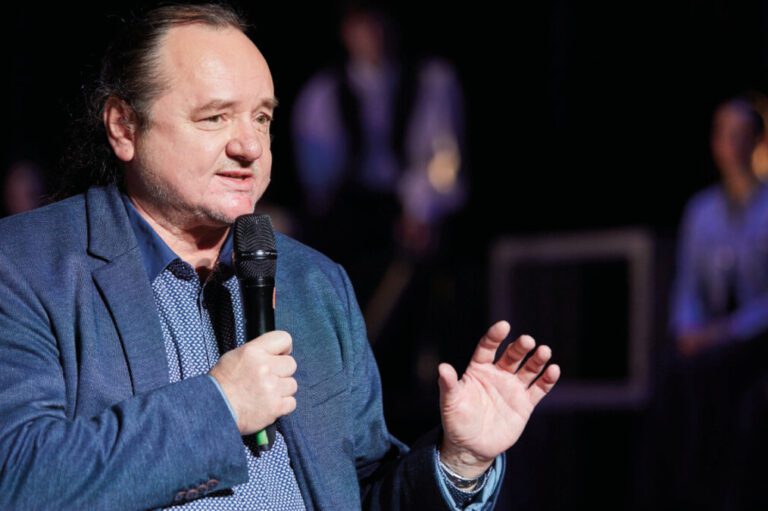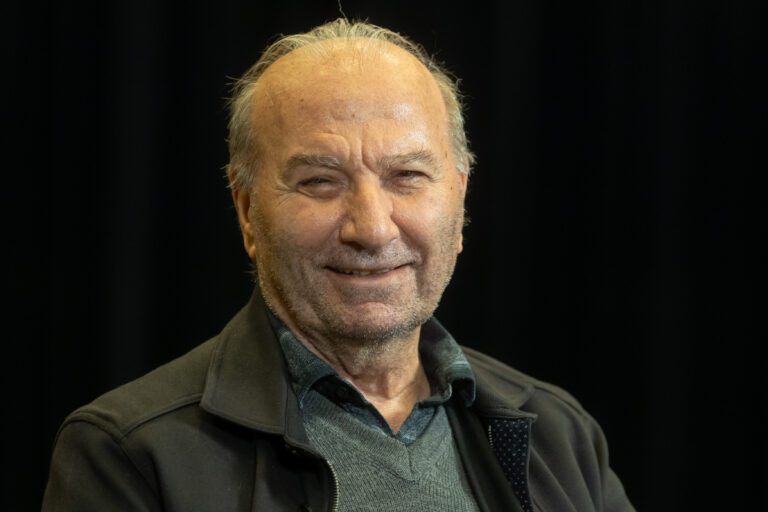World-renowned Greek director, president of the International Theater Olympic Committee, Theodórosz Terzopulosz founded the Attis Theater in 1985. During the creation of his first production, a specific working method was developed, which already contained the most important elements of Terzopoulos’ artistic credo. The director’s writing published in Szcenárium – which is the core material of the volume entitled The Return of Dionysus, published in 2015 – brings this workshop full of discoveries close to the reader.
The performer at the center of the stage, in front of him the ecstatic God of theater, Dionysus, child of a double birth, both of Zeus and Semele, exponent of mutually exclusive and fluid identities, woman and man, angry and meek, god and animal, on the borderline between madness and logic, order and chaos.
His body open to inner and outer stimuli, changing constantly, balances on a tightrope between life and death. The body of Dionysus is dismembered only to be recomposed, regenerated. In the myth’s journey, Dionysus appears as Adonis in Syria, Osiris in Egypt and Attis in Phrygia. Heraclitus, in one of his dark excerpts, identifies Hades with Dionysus: Hades and Dionysus are one and the same.
The fertilizing Dionysus invites the performer to seek the archetypical body, hidden in the depth of his structure, oppressed and repressed by the mind. This Body, with sources of unprecedented psychophysical energy, is the performer’s main material; its boundaries extend beyond the limits of the physical body. It is constantly reformed by memories deeply engraved in the performer’s structure.
The performer is invited to liberate the multiple dimensions of his inner material and fruitfully cultivate the sense, the instincts, the imagination and the Idea of the Core. He resists narcissism which creates a distorted image of his body. He overcomes the barriers of fatigue and tries to dilate the limits of mental and physical stamina. He develops the ability of reflective reaction to inner and outer stimuli and tries to cast off the innumerable fears and constraints imposed by everyday life.
The body-voice training helps the performer go beyond the limits of linear perception of time and space. Time loses the linearity of social conventions, expands and contracts, slows down or progresses with leaps and bounds, becomes silent, is projected in space and creates cracks in the man’s compact image of the world.
The performer explores materials concerning not only the art of theater, but in a broader sense, human nature and the world. A permanent task is the liberation of the blocked energy throughout the whole creative spectrum from research to performance.
The performer’s daily training does not intend to produce rapid acting results, which entrench the imagination in a closed system of inviolable technical rules. It mobilizes the functions of awareness and modulates the Body of Energy. In modern physics Energy is a measure of an endogenous capacity of the body, of motion. Energy, then, is motion, the constant change of the body in space and time, but also the inner motion, the e-motion. Energy is not an abstract idea, is not implanted from outside, as an order to the performer, but is perceived as an experience and physical memory. The question arises: How will the performer’s body be the carrier of the material at hand? How can the voice and the body be cultivated?
Deconstruction
The idea of deconstruction and the basic steps of its development were born during the workshops of Euripides’ “Bacchae”, the first performance of Attis Theater. This performance was the fertile soil for the creation of a working system, which has been implemented interculturally, in several places, with performers of different cultural backgrounds. On the occasion of Bacchae, Ι started investigating with my actors in northern Greece the remnants of Dionysian rituals, looking stubbornly for the hidden sources of physical energy. It was a very painful and interesting research.
We found in our bodies forgotten echogenic sources; through the research, we even tried to meet traces of our deepest memory. We were improvising for hours, trying to activate our body globally, wanting to know its dark and mysterious tradition, dancing sometimes awkwardly, twisting around in an agitated manner, trying to reconsider the world, keeping the eyes of our body opened, expanding the limits of our body, of the body which never knows its maturity.
We were sensing that the body should be ready to be reformed, exposed to all kinds of stimuli, improvising constantly, maintaining a love affair with tradition; trying to unite the opposites, dancing the crazy dance of the opposites’ conflict. It is shocking to feel the limits of your body penetrable, the energy channels opened and activated the places of mutating the primary materials. We were walking with the faith that our body does not need to mature, as if it was never born and each time it tries to be re-born. We were trying to provoke the uprising of deeper forces, to tear down the walls which were keeping us immersed in ourselves, to bring forth images from the space of the unconscious, to fly out of our known limits. We realized that our duty is to make the people our accomplices and let them be our partners in the long journey to the country of Memory, the country which hides the primary body and the primary language.
A means for this trip was the “exercise of deconstruction,” born and fermented during the rehearsals of Bacchae. The exercise of the deconstruction of the triangle (see dvd) is the cornerstone of my work, it creates the idea of the group. The performers walk for hours, within a collective rhythm, in a circle. Their walking is natural, neutral. They maintain the sense of the triangle, keeping activated the diaphragmatic breathing, supporting the spine without unnecessary tensions. The body is as relaxed as possible.
Elbows and knees bend so as to create a global sense of the body. Gradually the position of the hands changes. Firstly, they go up at shoulder height, bent, with the angulars projected and then over the head. Wrists and palms are relaxed. At the beginning, the pace is very slow; the acceleration is gradual, without any hurry. At each step the soles’ center roots on the ground.
The importance of the sole’s contact with the ground is great, as it is a perfect miniature of the entire human organism. In the sole of the foot there are 7,200 nerve endings; as a result, the specific pressures and compressions caused by each step, create a reflective stimulus at each point and organ of the body, activating the nervous system of the organism and the blood circulation. During the cardiac cycle, when the blood goes up again from the legs to the heart, there is a necessary boost needed. For this purpose the body has two appropriate mechanisms. The venous system in the sole of the foot is the first: with the pressure created at each step by the weight of the body, the venous system acts as a “sponge” which is pressed, and pushes the blood upwards. The endings of the nerves are perfused, they accelerate the blood circulation and raise the temperature. Then takes over the second mechanism, the muscle pump of the leg; while it contracts, operates in the same manner. This mechanism is activated by walking, while the veins of the legs act as conduits that carry blood from the legs to the heart.
During the exercise, the collective rhythm of the group accelerates. The performers walk faster and faster. I often participate in the process so as to support the rhythm. The sole’s rooting on the ground is preserved throughout the whole duration of the pacing. Spine and head remain loose. Gradually the torso tends downwards. The stimulation of blood circulation increases the body temperature and causes perspiration. The work on the sole of the foot, the vibrations caused and the rising of the temperature, activate the body and eliminate the flow of thoughts. The growing tension created by the escalation of the collective rhythm and the feeling of tiredness, expand the limits of mental and physical stamina. It is important, always to maintain the sense of inner relaxation, which allows the body, despite the escalation of tension, to spend the necessary amount of muscular energy, remaining open as a receiver to inner and outer stimuli. At the extreme point of the collective rhythm’s development, the performers slightly loose the sense of space; of course, the natural control is in function.
Then, very carefully, they fall to the ground on their back. They maintain briefly the natural panting and push the air in the depth of the lungs, so as to mobilize the diaphragm, the kidneys and the rectus abdominis. When they relax, the performers find the control of the breathing cycle. They bend the knees and bring the spine and the waist in contact with the ground; they breathe in a fragmented way with the phoneme “ha”, through a series of diaphragmatic pulses. It is important to have the sense of an effortless production of “ha” from the diaphragm, so as not to push at all either the larynx or the chest at all. When the performers realize the new way of breathing, they also inhale in the same way. The discontinuous diaphragmatic inhalation and exhalation continues at an accelerated rhythm until one “penetrates” the other. The respiratory function is now carried out very quickly, without pressure, from the nose and the mouth, at irregular intervals and rhythms, in a manner which reminds us the dog’s breathing when he pants. This mode of respiration makes the diaphragm stronger and more flexible.
Then the performers gather their sense on the spine and the triangle, where the air of the discontinuous breath of diaphragmatic pulses causes many small vibrations. The triangle receives these vibrations and accumulates the energy they gather, till it becomes their transmitter. Now the rate of the discontinuous inhalation and exhalation depends on the repeated anteroposterior vibrations of the triangle, which begins to move autonomously, till the complete relaxation of the lower vertebrae. The performers experience the area of the pelvis as a guide and a key source of energy in the body. Through the activation of the triangle, its vibrations spread throughout the whole body, while the sense of inner calmness should be constantly cultivated.
As the performers become familiar with the above process, they slowly change the body position, locating and realizing the function of different points in the intervals from one physical position to the next.
The evolution of the movement from point A to point B is continuously analyzed into many small interspaces which create their own points. The performers choose difficult positions, so as to investigate the behavior of the body within them. In a very slow tempo, without never stopping the function of the triangle, they return back to the upright position. Breathing is free. The air comes and goes effortlessly. The knees are slightly bent to facilitate the movement of the pelvis. The muscles of face, shoulders, chest and back, are completely loose.
The performers locate blocked points in the body, which gradually loose. They move in the space slowly. The vibration of the triangle develops throughout the body, releasing the cervical vertebrae, reaching the head, on which the performers work carefully, thoroughly, without frivolous and sudden movements. The triangle, through its vibrations and pulsations, injects energy to the whole body, creating unprecedented positions and varying rhythms. Opposing forces are activated, the “cross” of the body, diagonals and opposed axes, new counter rhythms are born. The performer gives an order to a part of the body, eg. to a finger, which begins to move autonomously from the rest of the body. The cooperation of the physical point to the mind is very helpful.
The movement from the finger is transferred to the wrist and from there to the entire hand, while the elbow is bent to transfer more energy. A part of the body may be autonomous and assume the dynamics of the center: shoulder, finger and elbow. Thus, the off-center is strengthened and as a new energy center, collaborates with the precedent that, although now is subdued, never loses its dynamics. In parallel with the function of a limb, another part is activated in response to the first, which gives birth to its own, different, pace.
In the exercise of deconstruction, the basic function of the triangle does not stop, it becomes more dense and internal. The performers’ physical axles relax and become fluid; through contrasting flows and unpredictable bursts of energy, become autonomous, energy axles, components of the triangle’s vibrations and of the impulses that cause, giving birth to unknown till that moment expressive codes, revealing echogenic sources which have not been used again. Energy axles multiply at breakneck speed, and each time, at the intersection point, new axles are created, with new tempo-rhythms, in infinite spindle movement. The facial muscles dilate, eyes and mouth are magnified and the euphoria which the performers start to feel, multiplies the energy and strengthens the stamina.
The pauses in the function of the triangle help the performers realize what happens within the body: the opening of the inner space and time. Time deepens and the performers are taken by surprise. The body turns into an alive resonator of vocal vibrations. The performers investigate various possibilities of sound production, without restriction, with vocalisms, breaths and forgotten tunes of their own tradition.
All kinds of resistance are eliminated. The ecstatic bodies of the performers, on the borderline between order and chaos, are open and perforated, exposed to all kinds of stimuli. Gradually they are reconstructed, regenerated as energy bodies, as bodies- primary material. Through this process, the performers condense the inner energy and acquire its constant feeling. The body projects new bodies, the subconscious – core becomes a reservoir of energy and a powerful source of Art. The body becomes a battlefield of fermentation and artistic expression.
Rhythm
Rhythm gives birth to Form. Even the most abstract shape, the most fleeting movement born by the rhythm, is based on a deeper logical law. If you can find the core rhythm in two phrases, the rhythm which characterizes the entire section will be uncovered and after that, the rhythm of the whole text. I believe that the text consists of rhythmical sections, especially in ancient Greek tragedy. Many times I am amazed, because, without prefabricating the rhythm through a dramaturgical process or through a directorial preparation imprinted on the paper, the process of deconstruction, analysis and reconstruction of the material is born by the rhythm.
In the rehearsals of Bacchae, our research material was the phrase “kamaton t’ ‘efkamaton (κάματον τα’ ευκάματον)”. Bacchae come to Greece from Asia, accompanying Dionysus and singing “kamaton t ‘efkamaton”; it means “we are tired, tired but happy.” This phrase has often been attributed in an entirely descriptive way, where the Bacchae come on stage tired; they rest on some stones of the ancient theater, as if they want to rest. While we were investigating “kamaton t ‘efkamaton”, we found the rhythm of the pyrrhic dance. Bacchae come dancing the dance of fire, stepping their feet on earth, like in the Pontiac pyrrhic dance or in some relative dance of the East. The performers of Bacchae, intoxicated, were driven in an unexpected burst of energy and through the cracks of their deconstructed body, were bringing forth bright, rebellious materials, ready to be transformed.
I believe there are no punctuation marks in theater. There is no full stop, comma, exclamation mark and bracket. All these, which the bourgeois theater uses extensively as dynamic elements of its expressive language, do not exist. There is always a temperature below the speech and too many variations of the inner sounds. Usually, I follow the rhythm and I do not refer to specific images, wanting to catch the end of the thread. I follow the rhythm, aiming at a point of this abstract and unruly material, exploring its limits.
I follow the rhythm as if I’m one of its components and I am often lead to an unusual landscape, where the speech is not illustrative, but natural. Many times speech-pain. For me the speech is not its conceptual interpretation, its description, but the image of the word’s structure, its internal cause. And here is my point of difference from the notional theater. I am interested, how someone, while he is interpreting a phrase, can discover even its echogenic source, its core rhythm.
